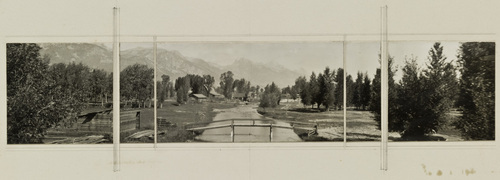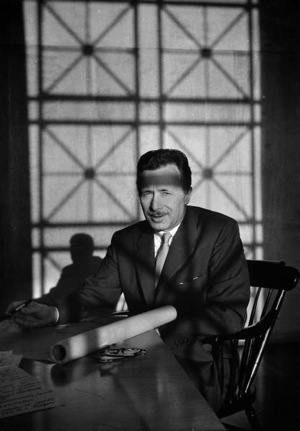
Resor House Project, Jackson Hole, Wyoming, Perspective and view of site from interior Ludwig Mies van der Rohe (American, born Germany. 1886-1969)
Pietro Belluschi: Portland’s Sustainable Maverick
The Equitable Building, a 12-story office tower for the insurance company of the same name, always caught my eye when I lived and worked in Portland in the early 1970s. Its gleaming green glass and aluminum cladding was far more “modern” than any building in town. I didnt realize it had been conceived more than thirty years before. Looking at pictures taken after its completion in 47, the cars appear dated, not the architecture.
The war had imposed a moratorium on civilian construction. Perhaps to keep up the spirits of architects in the time of dearth, Architectural Forum published an issue, “New Buildings for 194X”, calling for “an advanced but not stratospheric approach to planning, construction and equipment – and that (architects) draw upon technology that was currently available but not yet in common use.” Along with Louis Kahn, Mies van der Rohe and William Lescaze, architects much better known than he was, Pietro Belluschi submitted ideas. His included double-pane windows, insulated aluminum spandrels, air conditioning, radiant heat, and acoustical ceiling panels. Equitables multivalent significance begins with its location, extends to its style and its building system, and continues with its geothermal heating and cooling system.

Pietro Belluschi
Portland in the 40s was a second or third tier American city, not the financial capital of New York, or industrial powerhouse, Chicago, where one expected architectural innovation. But Equitable preceded Gordon Bunshafts Lever House on Park Avenue, and Mies van der Rohes Lake Shore Towers by about half a decade. Northwest manufacturing and environmental qualities suited Portland to architectural innovation. Belluschis engineering background provided the resources to exploit them. He foresaw the postwar surplus of aluminum, a locally mined material. Hey, Boeing had been churning out B-29s up in Tacoma. The confluence towns of the Columbia and Willamette rivers that had concentrated wartime shipbuilding delivered high metalworking skills and a postwar workforce for new construction. Water flowed generously; hydroelectric power from the Bonneville Dam was cheap. These were ingredients of a sustainable architecture.
Belluschi found the client for his dream in Ralph Cake, the Equitable executive in charge of establishing a new headquarters in Portland. Cake embraced Belluschis new technology. Belluschi gave him the most advanced building in the world. The interior was modularly subdivided for maximum flexibility, a free plan on a reinforced concrete structural grid. The rationalism may be old- fashioned but here its complete. Belluschi discarded the original idea of an aluminum frame because of the metals low melting point. The exterior cladding followed an earlier Belluschi dictum expressed while designing the Portland Museum of Art in 1932, “Let us not twist the body to fit the suit, but let us build a new suit consistent with the body.” The natty Italian believed in the analogy between architecture and the human form.
The building envelope is the first modern transformation of the spirit of the “Chicago window” found in Louis Sullivans Carson Pirie Scott department store of 1899. Double-pane insulated windows set flush to the grid of aluminum panels clothing the concrete frame, skinning its voids. Juxtaposition between opacity and transparency in the sheer surface imparts an unmistakable tension to the stereotomic box. Green tint in the outer glass absorbs solar heat and reduces interior glare to obviate the need for shades. Pittsburgh Plate Glass developed a process just to float glass of this size.
The glazing so valued by Belluschi reflects the city and the sky. The tint makes aqueous office life inside. Aluminum and glass in functional union turn decorative, giving Equitable its charm. Belluschis may have been the first exploitation of glasss reflective quality in the iconography of a building. But Equitables reflective surface has an unbuilt precedent in a design by a senior modernist in the West.
Belluschi broke the first International Style ground in the West. But Miess first American commision, a house for Stanley Resor (1937-41) in Jackson, Wyoming preceded him in Modernism. Mies often inserted collage into his renderings, and in a conceptual drawing of the Resor house he acknowledged the Western landscape.
Resors structure frames a Bierstadtian panorama of the Tetons: Mirror, view, or both? Belluschi made the idea of window as mirror and view material in the reflective body of Equitable – an ambiguous equation of exterior and inside.
Geothermal temperature regulation of the sealed building, via heat pumps, put Equitable in its own league compared to its contemporaries and set a benchmark, making it first for sustainable mechanical systems in a building of its size. Drawing on cool and warm water wells – theres a dormant volcano within the city limits – a system of heat pumps, compressors, and evaporators conditioned the air to be be ducted to a fine grain of zones throughout the building. In 1984 the building used only 57 percent of the DOE-mandated energy load limit. According to Brian Pierce, Equitables manager (its current name is “Commonwealth Building”) the geothermal system now is bypassed but remains intact. The City of Portland levies prohibitive fees for discharging the volumes of cycled well water into its municipal sewer system. One hopes Puddle City wises up. Perhaps they could discharge to the storm sewer. As Pierce commented on the geothermal system, “Its the ultimate in sustainability” – and suited to Portlands temperate climate.
Bellluschis Equitable Building gets respect. Its on the National Registry of Historic Places and is a National Historic Mechanical Engineering Landmark. Its greater significance lies in its proving that in architecture, technical and theoretical knowledge know no boundaries. Through the 60s and 70s commercial expediency and careless mechanical engineering tarnished the International Styles reputation. Equitable shines as one of its first and highest achievements. Henry Miller wrote of the skyscraper and the corporate life it housed as The Air-Conditioned Nightmare. Equitable remains exemplary of how things should be done.
Ludwig Mies van der Rohe (American, born Germany. 1886-1969)
